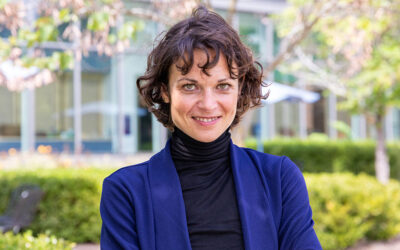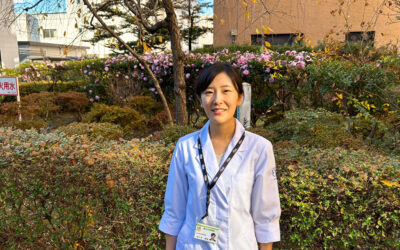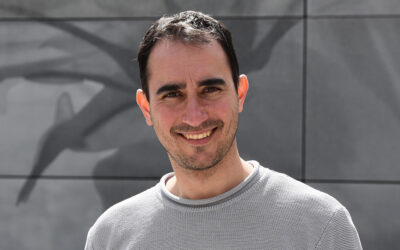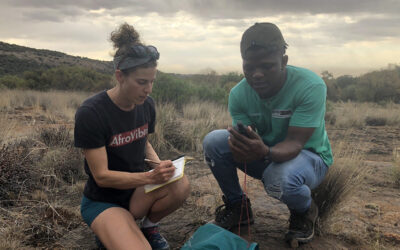Wouldn’t it be great to have a sustainable material that can be grown from small quantities, capable of aiding in wound healing, delivering medications, and even heating buildings?
That’s the promise of engineered living materials, also known as active and response materials. These cutting-edge materials consist of a scaffold populated by or even built from living cells, which react in specific ways to different stimuli. Even more impressive is their ability to sustain, regulate or heal themselves.
These materials can be made using easy-to-grow cell types such as yeast, fungi, and fast-growing bacteria strains such as Escherichia coli or Bacillus subtilis to achieve the desired material response. However, to provide the appropriate material response, the cells must be able to thrive in their engineered environment, just as they would in their natural habitat or in a controlled laboratory setting.
One interesting area of application is using living cells to make responsive and sustainable building materials. They could be used to repair the damaged exterior of a building or sidewalk by simply growing in to fill the space or fix discoloration on buildings without needing manual labor or painting. While the applications are forward-thinking, bacteria thrive in specific temperature ranges, making the concept of harmonizing an ideal growth temperature with natural seasonal temperature fluctuations challenging.
To overcome this problem, a Caltech team led by Michael Shapiro and Julia Kornfield have created a bacteria-based material that is able to strategically harness sunlight to modulate temperature for protein production and cell growth. This allows a favorable response to unavoidable exterior temperature changes above and below the cells’ optimum temperature to keep the bacteria population healthy and the material fully functional and responsive.
Together with their former Ph.D. student, Lealia Xiong, who conducted the work as part of her thesis, Kornfield and Shapiro took the time to talk to us about their engineered living materials and how they can be used as building materials in a variety of outdoor applications, from cities to rural villages to your own backyard.
What are engineered living materials?
Lealia Xiong (LX): Engineered living materials are materials that have living properties. They can be either composed of cells inside of a synthetic material or they could be composed entirely of cells and polymers that they are making and secreting to form a networked material.
What is their history?
LX: Synthetic biology itself is about 20 years old at this point and interest in making engineered cells into materials has been growing a lot in the last decade.
Mikhail Shapiro (MS): It is a long-held vision that we are going to be able to make materials based on living things. In fact, we already do that all the time. The trees around us are a living material, just not an engineered living material.
The idea is to harness the capabilities of biological systems to make new kinds of materials that do not exist in nature. That has been a dream of biological engineers and synthetic biologists for a couple decades.
Where are they being applied and what relevance do they have?
LX: As Mikhail said, because it is relatively new to be able to actually make such materials, I think most studies are in a proof-of-concept phase. However, what is really interesting about the idea of an engineered living material, and why we are so keen to make them, is that living cells have fascinating properties like the ability to grow from a small amount to a large amount, such as trees, which start from a little acorn and grow into a huge oak. Being able to control what material you are growing through engineering would be very interesting.
There is also self-healing. The cells that we use are E. coli and they replicate very quickly. If you damage your material with some sort of laceration or hole, the hope is that the cells would divide and be able to fill in that space and, because [they produce polymers to build] the material themselves, you could have a healed wound that is almost identical to the bulk of the material and you would not have as much of a scar.
Could you use cells from any organism to create these materials and are there technical and ethical restrictions?
LX: We work with bacteria, which are generally safe. E coli are commensal bacteria [microbes that naturally reside on or within the body]. In humans, and we have a generally good relationship with them. B. Subtilis used by our collaborators is also generally safe for humans. The systems that we use are not one-to-one, so we are not able to plug any bacteria into them, but they could be relatively easily adapted for use in other bacteria.
I know there is a lot of interest in the engineered living materials community on using fungus. Yeast for example is commonly used in synthetic biology but there is also interest in mushrooms because mushrooms can grow also incredibly rapidly and the mycelium is a pretty tough material and might be easier to build into three-dimensional structures, whereas our samples are envisioned to be more of a coating.
How are they made?
LX: The material that our collaborators at Caltech in the Tirrell lab are developing use either E. coli or B. subtilis [both bacteria] as the living component. My work was in E. coli and the way that we made the model samples for our study was to first grow a small number of cells in liquid culture.
E. coli is very amenable to growing in liquid media and the cells replicate very quickly when they are in a controlled incubator. Then we deposit the E. coli onto a thin polycarbonate membrane through filtration and this deposits a really thin layer, barely visible to the naked eye. We then continue to grow them on the polycarbonate membrane. I worked on the centimeter scale, but we envision that these materials would be able to cover a large surface area and grow to a thickness of potentially a few millimeters.
Could you use human cells?
MS: I think it would be more difficult to use a mammalian cell line, though I do not think it is impossible. Generally, they are more finicky and divide more slowly than bacteria cells.
What about plant cells?
Julia Kornfield (JK): Chiara Daraio at Caltech is doing work on growing plant cells in suspension and using that mode of growth to enable combining them in new ways with other materials. She has not yet done it on a film but there are people who do. One of our colleagues Gozde Demirer and is developing new tools for editing the genome of plants to give them a desired engineered function and as that comes along, maybe that could cross-pollinate with the bacterial living materials. It would also be exciting to see what happens with fungus.
Your team has recently implemented a temperature-responsive feature to improve the living material’s performance. What inspired this modification? How does this new feature work and how did you implement it?
LX: As I said, we work with E. coli, which is a star in synthetic biology because it has been well studied for many decades and we know how to engineer it. It is safe for us because it grows inside our bodies, but that means we need to keep them at a temperature of 37 Celsius. E. coli really adapted to this temperature, which is optimal for their protein production and their growth rate.
If we want to take E. coli cells and use them in an application outside of the human body, for example as a living, growing, self-healing building material, then they will be exposed to fluctuations in temperature, both day and night and on a seasonal basis. The concern is that if the E. coli cells are exposed to outside temperatures of 25 Celsius, then they will grow slowly. When that happens, we lose these desirable properties like being able to grow from a small sample into a large material, being able to self-heal and even just the functionality of creating the polymers that are forming the material.
Conversely, if E. coli were to get too hot, they start to lose their ability to make proteins and so we wanted to have a way for the E. coli to sense when they are too cool, which would be in most climates inhabited by humans, and then turn on a protective mechanism. The way that we implemented that was when the bacteria sense they are too cold, they produce a black pigment and that allows them to absorb energy from the sun and warm up.
MS: I just want to mention that for the genesis of this project, Lealia was the perfect person to lead this kind of work. After graduating from her undergrad at MIT, she took some time to work with a synthetic building materials company where they worried about thermal regulation for entire buildings. It was very natural for her to come to Caltech, meet up with synthetic biologists and material engineers and then started working on this problem of engineering bacteria to do the same thing that she had previously engineered for whole buildings.
How long does it take until these modified living materials are completely assembled and ready to use?
LX: On the lab scale, we were growing bacteria in the solid patch format to simulate the living material environment for up to three days and potentially longer. We have not had the opportunity to do studies on growing a much larger surface area, so I think that question is currently unanswered. All our collaborators also working on a similar sort of centimeter scale.
MS: Another piece of context is that this project was funded by DARPA originally and they are far out looking agents whose job it is to look around the corner to see what is coming in the next decades in science. This is about developing a fundamental set of capabilities that together with other components would allow the larger scale up and will at some point have applications out in the field. At this point, it is about being able to regulate temperature to enable sustained growth. The function of these cell types is a really important puzzle piece that we are putting into the puzzle.
JK: This is still truly science fiction but one thing you can imagine is having a vial of liquid and, instead of just spreading a little bit on a tiny patch, you have a technique that allows you to inoculate a large surface that could grow in a short amount of time, like three days. That is way down the road and there is no infrastructure for even demonstrating that.
How long do your bacteria live after you create this thin layer and are there different ways of feeding them to keep the material fit and alive?
LX: We envision that the bacteria would be sitting on a polycarbonate membrane, which is porous and allows nutrients and water to pass through, and then have [built-in] piping to bring fresh nutrients and take waste away because bacteria are hungry. You can really control the rate of growth by restricting or adding more nutrients, so that is something that might be interesting later on. They are also fairly hearty, so if you start starving them, they are not necessarily dead right away, which is also a nice feature.
I noticed that Agar [a gelatinous substance that is extracted from seaweed conventionally used in synthetic biology to grow cells] was not necessarily the best medium to grow our living material samples on because it dries out fairly quickly under our growing conditions. I figured out that we could use liquid medium and then mimic a circulatory system using capillary action through a foam or sponge to bring the liquid media up to the bacteria. This helped to reduce some of the problems we saw with Agar where the whole Petri dish would shrink up and stop providing nutrients to the bacteria.
We envisioned that even just using this sponge or foam system we could have nutrients pumped into a reservoir and then brought up to the bacteria by sponge and also pumped out through the bottom. That way we get some separation between where the nutrients are stored and our material.
Where do you envision daily usage and what is needed to achieve production on an industrial scale?
LX: As Mikhail said, we were funded by DARPA and they are interested in being able to grow materials in remote locations. The advantage of the living material, as Julia mentioned before, is that you bring a small starting culture to your site, and you can use local resources to provide water and nutrients and then grow your specialized material from those really basic local resources. This would be advantageous in the military, for example, as they are often located very remotely from parts of civilization. Outside of the military, this could be very useful in rural areas in general.
MS: I hope someday, maybe a couple of decades from now, I will be doing touch up painting on my house with a living paint, where that paint would eat rust and repair itself and make the house look nice, maybe change colors during seasons. I think that should be in principle possible, it is just a matter of time before we get there.
What would be the production costs?
MS: There are challenges with living material because you need to supply it with nutrients and being able to harness nutrients from the environment is something we would ideally also engineer into these materials, perhaps with photosynthetic pathways.
I think that would be the major cost. The beauty of using biology is that it grows, so you can start with a small number of cells and have it grow and assemble into a more sophisticated material. I would guess that starting with the biological materials should not be that expensive. It would be more the maintenance and nutrients that would be potentially a higher cost.
Are there any developments in living materials you would like to see in the future?
JK: The idea of having self-regulating temperature is to enable yourself to keep doing another job, so looking at the crosstalk between functions would be really interesting and seeing whether or not conferring the ability to keep temperature more uniform actually enhances your ability to do some other function better. That would be a very exciting next step.
What would it mean for you if your engineered living materials become commercially available?
MS: Personally, I think it is a little early to think about commercial prospects for this kind of material. At this point we are trying to change the way people think about what is possible. It will take quite a bit more work, not just from our groups, but really from the broader synthetic biology community to make engineered living materials a commonplace commercial reality.
Reference: Julia A. Kornfield, Mikhail G. Shapiro, et al., Living Material with Temperature-Dependent Light Absorption, Advanced Science (2023). DOI: 10.1002/advs.202301730
Feature image credit: Should Wang on Unsplash

















